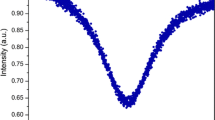Abstract
The accuracy of spectrograms may be affected by baseline excursion or drift when infrared spectrometers are used in the analyses of gases. Background deduction or baseline correction is one of the effective pretreatment methods that can improve measurement accuracy. This paper presents a novel methodology based on complex wavelet transform algorithm to perform background deduction. The complex wavelet transform methodology establishes a complex wavelet filter to decompose the spectral signals first, and set the decomposition coefficients in the high-frequency section to zero, and then reconstruct the background signals; finally, the background deduction can be realized by deducting the background signals. In this study, the complex wavelet established by Daubechies was selected to demonstrate background deduction aiming at simulative spectral signals with different backgrounds and the real spectral signal of SF6 decomposition gases. Compared with the results done by the real wavelet transform in the same conditions, the results indicate that complex wavelet transform methodology can perform background deduction more efficiently than real wavelet transform methodology, thus improving the effectiveness and precision of spectrogram measurements greatly, which is useful for SF6 gas decomposition compositions analysis










Similar content being viewed by others
References
Komsta L (2011) Chromatographia 73:721–731
Shao LM, Lin XH, Shao XG (2002) Appl Spectrosc Rev 37:429–450
Andrade L, Manolakos ES (2003) J VLSI Signal Process Syst Signal Image, Video Technol 35:229–243
Liu R, Gu XY, Xu KX (2008) Spectrosc Spect Anal 28:1772–1775
Boelens HFM, Dijkstra RJ, Eilers PHC, Fitzpatrick F, Westerhuis JA (2004) J Chromatogr A 1057:21–30
Kuligowski J, Quintás G, Garrigues S (2010) Talanta 80:1771–1776
Brauns EB, Meier RJ (2009) Vib Spectrosc 49:303–304
Qu HB, Ou DL, Cheng YY (2005) J Zhejiang Univ-Sci B 6:838–843
Peng D, Xu KX, Gao J (2009) Chin J Sci Instrum 30:20–24
Kuligowski J, Quintás G, Garrigues S (2009) J Chromatogr A 1216:3122–3130
Harimoto T, Takeuchi Y, Fujita M (2005) Opt Express 13:5689–5693
Liu Y, Liu K, Tao WL (2010) Spectrosc Spectr Anal 30:1688–1691
Sun DH, Zhang ZG, Gu S (1998) Spectrosc Spectr Anal 18:194–198
Zhang X, Zhou J, Li N, Wang Y (2012) IET Gener Transm Distrib 6:353–362
Zhou X, Zhou C, Kemp IJ (2005) IEEE Trans Dielectr Electr Insul 12:586–594
Ma X, Zhou C, Kemp IJ (2002) IEEE Trans Dielectr Electr Insul 9:446–457
Driesen J, Belmans R (2002) Circuits Syst 5:681–684
He HB, Chen SJ, Zhang YB, Nguimbis J (2004) IEEE Trans Power Delivery 19:86–91
Tang J, Xu ZR, Sun CX (2009) Eur Trans Electr Power 19:313–322
Hu YG, Shen AG, Li W, Wang XP, Hu JM (2007) Chemometr Intell Lab Syst 85:94–101
Tan HW, Steven DB (2001) J Chemom 15:647–663
Singh BN, Tiwari AK (2006) Digit Signal Process: A Rev J 16:275–287
Ge M, Zhang GC, Du R, Xu Y (2002) J Vib Control 8:1023–1032
Choe JM, Woo JH, Kim DG (2006) International symposium on discharges and electrical insulation in vacuum 2:604–607
Kumari RSS, Sadasivam V (2007) IJWMIP 5:399–415
Leung AKM, Chau FT, Gao JB (1998) Chemometr Intell Lab Syst 43:165–184
Shao XG, Ma CX (2003) Chemometr Intell Lab Syst 69:157–165
Schulze G, Jirasek A, Yu MML, Lim A (2005) Appl Sepctrosc 59:545–574
Chen D, Shao SG, Hu B, Su QD (2004) Anal Chim Acta 511:37–45
Chen D, Chen ZW, Grant E (2011) Anal Bioanal Chem 400:625–634
Acknowledgments
We gratefully acknowledge the financial support from the National Natural Science Foundation of P.R. China (Grant No. 60701020) and the Natural Science Foundation of Hubei Province of China (Grant No. 2011CDA099).
Author information
Authors and Affiliations
Corresponding author
Rights and permissions
About this article
Cite this article
Hu, Y., Zhou, J., Tang, J. et al. The Application of Complex Wavelet Transform to Spectral Signals Background Deduction. Chromatographia 76, 687–696 (2013). https://doi.org/10.1007/s10337-013-2456-0
Received:
Revised:
Accepted:
Published:
Issue Date:
DOI: https://doi.org/10.1007/s10337-013-2456-0




